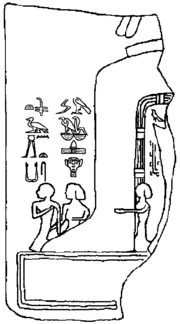Hetephernebti
| Hetephernebti in hieroglyphics | ||||
|---|---|---|---|---|
| Surname |
Hetephernebti (Hetep her nebti) Ḥtp ḥr nb.tj The countenance of the two mistresses is satisfied |
|||
| title |
Maa-Heru M33t-Ḥr.w The the Horus must look |
|||
| Hetephernebti (center) at the feet of King Djoser (limestone relief from Heliopolis) | ||||
Hetephernebti , also Hetep-her-nebti , was the wife of the ancient Egyptian king ( Pharaoh ) Djoser (around 2700 BC), the first ruler of the 3rd Dynasty ( Old Kingdom ).
Hetephernebti is known from two groups of objects. It appears on rough steles that were found at the Djoser pyramid complex in Saqqara , and on the fragments of a shrine from Heliopolis . There she appears accompanied by Inetkaes and another lady, whose name has broken off, which is why her identity is being discussed by Egyptologists. Hetephernebti may have been buried in the Djoserkomplex.
This queen bore the titles "Who is allowed to watch Horus" ( M33t-Ḥr.w ), " Great to Hetes-Scepter " ( Wr.t-hts ) and "King's daughter", which means she was probably sister or half-sister of her husband.
See also
literature
- Michel Baud : Famille royale et pouvoir sous l'Ancien Empire égyptien. Tome 2 (= Bibliothèque d'Étude. Volume 126/2). Institut Français d'Archéologie Orientale, Cairo 1999, ISBN 2-7247-0250-6 , p. 525 ( PDF; 16.7 MB ).
- Silke Roth: The royal mothers of ancient Egypt from the early days to the end of the 12th Dynasty , Wiesbaden 2001, pp. 384–85 (III.1.1 / 1) ISBN 3447043687
- Joyce Tyldesley : The Queens of Ancient Egypt. From the early dynasties to the death of Cleopatra. Koehler & Amelang, Leipzig 2008, ISBN 978-3-7338-0358-2 , pp. 38-40.
Individual evidence
- ↑ cf. Silke Roth: The royal mothers of ancient Egypt. Page 528, Fig. 22
| personal data | |
|---|---|
| SURNAME | Hetephernebti |
| BRIEF DESCRIPTION | Wife of King Djoser |
| DATE OF BIRTH | 28th century BC BC or 27th century BC Chr. |
| DATE OF DEATH | 27th century BC Chr. |
